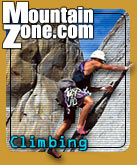Summit Day Details
Dispatch January 7, 2003
|
| |||||||||||
We didn't have much food left at our high camp, we were already sharing tea bags, the weather was mixed. We'd get clouds, then snow, then wind, occasionally it would clear up a bit. And I think probably most importantly, we wondered whether after our first attempt, which had gotten us within a thousand vertical feet of the summit, whether we really had enough energy left to make a serious second attempt.
Basically we'd be asking our bodies to make almost two complete ascents of Vinson from a very low altitude within a couple days of each other. We had discovered, on our first attempt, though, one potential camp site in the middle of the face. Just a tiny little ice hummock that had been pushed up to form kind of a dinner-sized tabletop platform of ice that we thought might fit a single tent. I think the minute you stepped outside, though, you'd want to have your crampons and ice axe on, because otherwise you'd slide back down the face.
Then the final thing we were (considering) was we were in a hurry. Two of us in particular, need to get back to work. We're actually due back to work today. And with our flight being delayed a week, we're a little bit behind schedule, so we needed to get both the ski plane back to Patriot Hills, Antarctica, and then on to Punta Arenas, in Chile. And that's very weather dependent.
So we had a lot of cards stacked against us. But we still really wanted to go up and climb the route. So we talked about it, and thought, well "let's see what we can do." It doesn't really make the most rational sense, but emotionally that's what we wanted to do, is finish what we set out to do.
We had to start in a complete whiteout. I think when I was in the front of the rope and looked back at the other members I couldn't see a single person hardly sometimes. And it was snowing lightly. Not too kind of a good way to start a climb, but after a couple of hours we climbed up out of the mist--it's really ice slog that forms over the continent--and up right above the clouds it was kind of like climbing up into heaven, looking up across...and it was really nice and warm up there. For Antarctica, that is.
We did manage to get the tent on the little ice platform. It's kind of livable for three, we managed to squeeze five of us in it. And (we) set out the next morning, after just a couple hours rest, for the top of the summit. So when we got up on the plateau, we'd done 7,000 feet of climbing, and that took us about 15 hours or so.
We got there at 15,000 feet, and it's really another world up there. It's kind of bulletproof ice. Crampons don't even sink in, and the temperature is about 10 below.
It took us about another 7 hours to get across the summit plateau. It's a huge expanse, with a lot of false summits. We reached the top about 1:30 in the morning. You come across a real spectacular ridge setting right on the top of Antarctica.
But it was relatively mild up there, there wasn't too much wind, so we were able to spend probably an hour getting photographs, plenty of congratulations. Obviously we were a bit tired, and still worried about the descent down, but I've kind of known from other climbs I've been on at elevation that once you get down a ways you start to feel a bit better, and after you've been to the top you get a little more energy.
So, we set off down to the...across the plateau... (unintelligible, transmission fails).
— Robert Anderson, expedition leader and MountainZone.com correspondent


